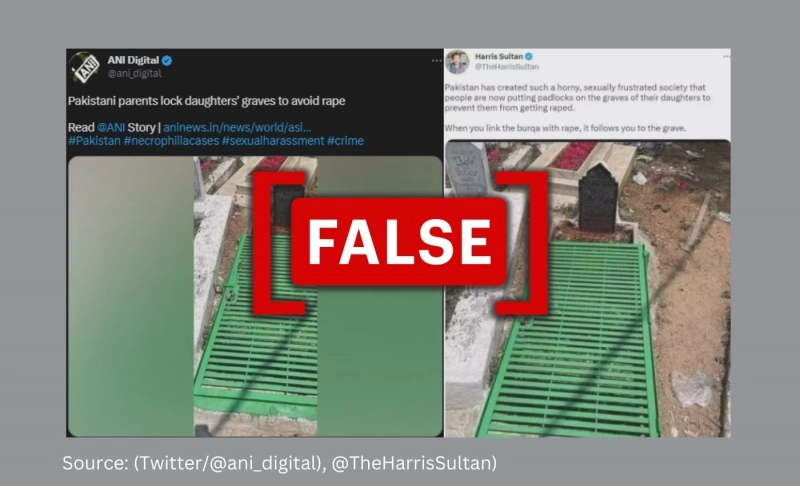By: Anurag Baruah
May 2 2023
Photo of padlocked grave in India’s Hyderabad falsely shared as precaution against ‘necrophilia in Pakistan’

The Verdict False
The photo is of a grave belonging to an aged woman who died over a year ago Hyderabad, India. It has no link to necrophilia in Pakistan.
Context
A photo of a padlocked grave has gone viral on social media with the claim that it shows Pakistani parents locking graves to prevent their daughters corpses from becoming victims of necrophilia. The claim was first amplified on Twitter by Harris Sultan, author of the book, ‘The Curse of God - Why I Left Islam’ - who tweeted the image on April 26, 2023, claiming that it was taken in Pakistan, which had a “horny, sexually frustrated society.” Later, Sultan’s tweet was picked up by Indian news agency ANI, which also quoted an editorial published by Pakistani news outlet Daily Times claiming that many were now putting padlocks on the graves of females to protect the bodies against rape. The ANI report led to various Indian mainstream media outlets like The Times of India, NDTV, Zee News, and Hindustan Times republishing and amplifying the agency feed.
ANI has now published a fresh, updated version of the story, admitting that the particular photo of the padlocked grave is from Hyderabad, not Pakistan. The Times of India and NDTV too published this corrected version. Meanwhile, Zee News and Hindustan Times have taken down their reports with the viral photo.
In Fact
We found a counter-claim that the viral photo was from a graveyard located next to the Masjid E Salar Mulk (mosque) in Hyderabad’s Darab Jung Colony. Taking a cue from this, we located the mosque on Google Maps. Using the Google Street View option, we found the same padlocked grave as seen in the viral photo situated right at the entrance of the graveyard next to the Masjid E Salar Mulk mosque.
Logically Facts got in touch with Muzaffar Hashmi, who confirmed that the grave belonged to his mother, adding that the graveyard is located in Hyderabad in India and not Pakistan, as falsely claimed by news media.
On Facebook, we came across a video where an individual, standing beside the grave, claimed that he had originally taken the viral photo in Hyderabad. He added that the grave belonged to his friend’s mother, an aged woman who had passed away approximately one and a half years ago. Comparison with the Google Street View feed showed that the video is from the same place and of the same grave seen in the viral photo.
Further, Muqtar Sahab, an official of Masjid E Salar Mulk, also explained in a video uploaded by Waris Pathan, National Spokesperson of All India Majlis-e-Ittehadul Muslimeen (AIMIM), that the grille was put because of instances of people burying bodies over old graves without permission. This particular grave was located right at the entrance, so the grille was also put to prevent people from stepping on the grave. Fact checking outlet Alt News was able to source this video via a social worker who visited the spot in Hyderabad at their request.
Sultan later took to Twitter and apologized for posting misinformation. While he deleted his original tweet containing the false claim about the photo, he pointed out that “the reason why it was believable is that necrophilia has become a serious issue in Pakistan.”
Sporadic cases of necrophilia have been reported in Pakistan. Pakistani English-language newspaper, Dawn, reported on August 15, 2021, about a teenage girl’s body dug out and raped in Thatta in the Pakistani province of Sindh. On October 30, 2011, the Express Tribune reported about a man named Mohammad Riaz who defiled the corpses of 48 women in the Paposh Nagar graveyard of Karachi, Pakistan.
The Verdict
The photo of a padlocked grave from Hyderabad has falsely been linked to necrophilia cases in Pakistan. The particular grave from Hyderabad was padlocked to prevent people from burying new dead bodies over it and also to prevent people from stepping on the grave, as it was located right at the entrance of the graveyard. Therefore, we are marking the claim as false.


